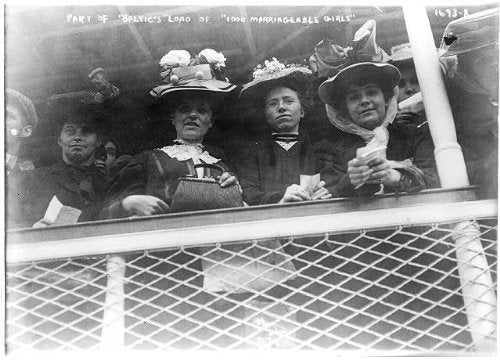A cautionary Valentine: They came to America for love, but found themselves on Heartbreak Island
In 1907 a ship sailed into New York harbour carrying 1000 marriageable women


Your support helps us to tell the story
From reproductive rights to climate change to Big Tech, The Independent is on the ground when the story is developing. Whether it's investigating the financials of Elon Musk's pro-Trump PAC or producing our latest documentary, 'The A Word', which shines a light on the American women fighting for reproductive rights, we know how important it is to parse out the facts from the messaging.
At such a critical moment in US history, we need reporters on the ground. Your donation allows us to keep sending journalists to speak to both sides of the story.
The Independent is trusted by Americans across the entire political spectrum. And unlike many other quality news outlets, we choose not to lock Americans out of our reporting and analysis with paywalls. We believe quality journalism should be available to everyone, paid for by those who can afford it.
Your support makes all the difference.A few New Yorkers still know Ellis Island as Heartbreak Island. It was there, in the shadow of the Statue of Liberty, that thousands of immigrants from all over Europe arrived after long, desperate but hopeful voyages across the Atlantic at the turn of the 20 century. Many, like The Godfather himself, stepped off the boat and into a new life, but others, without the right documents or with suspect health, were turned round and sent back where they came.
But Heartbreak Island is always the place I think of on February 14, for the two wonderful stories I encountered while wandering round the museum that is now there (by myself) on Valentine's Day about a decade ago.
One is of the RMS Baltic, once the largest ship in the world, that sailed into the New York harbour in September 1907. It was carrying a cargo of “1,000 marriageable women”, mainly from eastern Europe. Many had been exchanging letters with husbands to be, promising hope of a better life, now waiting on the mainland, but whom they had never met. As the giant Ocean Liner came past the statue, it was met by a flotilla of little boats, full of hopeful men carrying flowers, and pictures of their sweethearts. Up on the decks hundreds of women were leaning over, clutching similar photographs.
A joyful scene, but not without a little heartbreak. Some men discovered that their betrotheds had found better options aboard the ship on the journey over. And for some women, the human form their long clutched photograph in human simply wasn’t to be seen. For them, the future was bleak. Single women couldn’t fully immigrate by themselves, and had to make their way to emigrant homes on State Street, now in the heart of Manhattan’s financial district, where many were preyed on by unscrupulous traffickers.
The other is the story of Ludmila K Foxlee, arguably the world’s first makeover woman.
Many women arrived on Heartbreak Island seeking dates that weren’t so blind. It was an expensive business, emigrating from Europe and often wives and children would be catching up with husbands who had left a decade a more ago, and for whom New York was simply the first stop of a lengthy journey into the heart of America where their husbands had built new lives. But one long voyage for womankind was a giant leap through the fickle vagaries of fashion. Enter Ms Foxlee, one of the island’s best known social workers. In the mid 1920's, she caught the attention of the American press by posing with newly arrived immigrants in eastern European folk costumes, and then immediately afterward in stylish American clothes, before sending them on their way to reacquaint themselves with husbands long used to the trends of the new world.
“Saving Heartaches with a Dash of Powder and a Comely Skirt" was the headline over one of many articles written about her. "10 or 15 years in America made a good deal of difference in a man's ideal of womanhood," said one.
Ms Foxlee was a native speaker of many eastern European languages, and her own take was a little more nuanced. Many women would be held on Ellis Island for some time, before they could make their way onward to meet the families they knew were waiting for them. “They tell us that we help lighten the burden of detention with our daily visits ... Above all this ... they want our friendliness ... almost all the people who need it get the friendly attention they crave."
Join our commenting forum
Join thought-provoking conversations, follow other Independent readers and see their replies
Comments